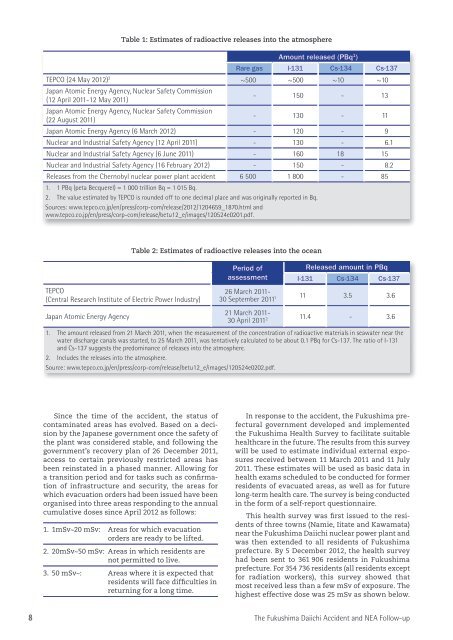Download the report in pdf format - OECD Nuclear Energy Agency
Download the report in pdf format - OECD Nuclear Energy Agency
Download the report in pdf format - OECD Nuclear Energy Agency
You also want an ePaper? Increase the reach of your titles
YUMPU automatically turns print PDFs into web optimized ePapers that Google loves.
Table 1: Estimates of radioactive releases <strong>in</strong>to <strong>the</strong> atmosphere<br />
Amount released (PBq 1 )<br />
Rare gas I-131 Cs-134 Cs-137<br />
TEPCO (24 May 2012) 2 ~500 ~500 ~10 ~10<br />
Japan Atomic <strong>Energy</strong> <strong>Agency</strong>, <strong>Nuclear</strong> Safety Commission<br />
(12 April 2011-12 May 2011)<br />
- 150 - 13<br />
Japan Atomic <strong>Energy</strong> <strong>Agency</strong>, <strong>Nuclear</strong> Safety Commission<br />
(22 August 2011)<br />
- 130 - 11<br />
Japan Atomic <strong>Energy</strong> <strong>Agency</strong> (6 March 2012) - 120 - 9<br />
<strong>Nuclear</strong> and Industrial Safety <strong>Agency</strong> (12 April 2011) - 130 - 6.1<br />
<strong>Nuclear</strong> and Industrial Safety <strong>Agency</strong> (6 June 2011) - 160 18 15<br />
<strong>Nuclear</strong> and Industrial Safety <strong>Agency</strong> (16 February 2012) - 150 - 8.2<br />
Releases from <strong>the</strong> Chernobyl nuclear power plant accident 6 500 1 800 - 85<br />
1. 1 PBq (peta Becquerel) = 1 000 trillion Bq = 1 015 Bq.<br />
2. The value estimated by TEPCO is rounded off to one decimal place and was orig<strong>in</strong>ally <strong>report</strong>ed <strong>in</strong> Bq.<br />
Sources: www.tepco.co.jp/en/press/corp-com/release/2012/1204659_1870.html and<br />
www.tepco.co.jp/en/press/corp-com/release/betu12_e/images/120524e0201.<strong>pdf</strong>.<br />
Table 2: Estimates of radioactive releases <strong>in</strong>to <strong>the</strong> ocean<br />
TEPCO<br />
(Central Research Institute of Electric Power Industry)<br />
Japan Atomic <strong>Energy</strong> <strong>Agency</strong><br />
Period of<br />
assessment<br />
Released amount <strong>in</strong> PBq<br />
I-131 Cs-134 Cs-137<br />
26 March 2011-<br />
30 September 2011 1 11 3.5 3.6<br />
21 March 2011-<br />
30 April 2011 2 11.4 - 3.6<br />
1. The amount released from 21 March 2011, when <strong>the</strong> measurement of <strong>the</strong> concentration of radioactive materials <strong>in</strong> seawater near <strong>the</strong><br />
water discharge canals was started, to 25 March 2011, was tentatively calculated to be about 0.1 PBq for Cs-137. The ratio of I-131<br />
and Cs-137 suggests <strong>the</strong> predom<strong>in</strong>ance of releases <strong>in</strong>to <strong>the</strong> atmosphere.<br />
2. Includes <strong>the</strong> releases <strong>in</strong>to <strong>the</strong> atmosphere.<br />
Source: www.tepco.co.jp/en/press/corp-com/release/betu12_e/images/120524e0202.<strong>pdf</strong>.<br />
S<strong>in</strong>ce <strong>the</strong> time of <strong>the</strong> accident, <strong>the</strong> status of<br />
contam<strong>in</strong>ated areas has evolved. Based on a decision<br />
by <strong>the</strong> Japanese government once <strong>the</strong> safety of<br />
<strong>the</strong> plant was considered stable, and follow<strong>in</strong>g <strong>the</strong><br />
government’s recovery plan of 26 December 2011,<br />
access to certa<strong>in</strong> previously restricted areas has<br />
been re<strong>in</strong>stated <strong>in</strong> a phased manner. Allow<strong>in</strong>g for<br />
a transition period and for tasks such as confirmation<br />
of <strong>in</strong>frastructure and security, <strong>the</strong> areas for<br />
which evacuation orders had been issued have been<br />
organised <strong>in</strong>to three areas respond<strong>in</strong>g to <strong>the</strong> annual<br />
cumulative doses s<strong>in</strong>ce April 2012 as follows:<br />
1. 1mSv~20 mSv: Areas for which evacuation<br />
orders are ready to be lifted.<br />
2. 20mSv~50 mSv: Areas <strong>in</strong> which residents are<br />
not permitted to live.<br />
3. 50 mSv~: Areas where it is expected that<br />
residents will face difficulties <strong>in</strong><br />
return<strong>in</strong>g for a long time.<br />
In response to <strong>the</strong> accident, <strong>the</strong> Fukushima prefectural<br />
government developed and implemented<br />
<strong>the</strong> Fukushima Health Survey to facilitate suitable<br />
healthcare <strong>in</strong> <strong>the</strong> future. The results from this survey<br />
will be used to estimate <strong>in</strong>dividual external exposures<br />
received between 11 March 2011 and 11 July<br />
2011. These estimates will be used as basic data <strong>in</strong><br />
health exams scheduled to be conducted for former<br />
residents of evacuated areas, as well as for future<br />
long-term health care. The survey is be<strong>in</strong>g conducted<br />
<strong>in</strong> <strong>the</strong> form of a self-<strong>report</strong> questionnaire.<br />
This health survey was first issued to <strong>the</strong> residents<br />
of three towns (Namie, Iitate and Kawamata)<br />
near <strong>the</strong> Fukushima Daiichi nuclear power plant and<br />
was <strong>the</strong>n extended to all residents of Fukushima<br />
prefecture. By 5 December 2012, <strong>the</strong> health survey<br />
had been sent to 361 906 residents <strong>in</strong> Fukushima<br />
prefecture. For 354 736 residents (all residents except<br />
for radiation workers), this survey showed that<br />
most received less than a few mSv of exposure. The<br />
highest effective dose was 25 mSv as shown below.<br />
8 The Fukushima Daiichi Accident and NEA Follow-up
















